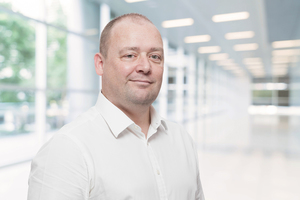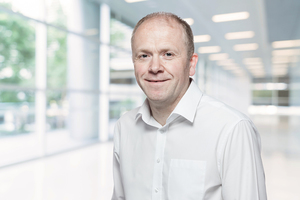
 |
Charlotte Stonestreet
Managing Editor |
| Home> | DRIVES & MOTORS | >Variable Speed Drives | >It’s time to think differently about circularity |
It’s time to think differently about circularity
11 December 2024
Charlotte Stonestreet reports on the latest Controls, Drives & Automation webinar, sponsored by ABB, which explored the intricate relationships between circularity, sustainability, and energy efficiency. Providing the expertise on the day were Steve Hughes and Richard Gee

In his opening remarks, Steve Hughes stressed the necessity of expanding beyond circularity to encompass broader sustainability goals. Highlighting data from the World Economic Forum, he noted the energy efficiency and retrofit market is anticipated to grow by 8% annually from 2024 to 2050, expanding its value from $500 billion to $3.9 trillion. This escalating demand underscores the urgency of implementing strategies that emphasise resource conservation and circularity. Sustainability, he explained, involves numerous small, incremental steps rather than a single, transformative action. By adopting this approach, individuals and organisations can contribute to reducing CO₂ emissions and preserving resources more effectively.
"It's not one big thing – If it was, it would be easy to fix – it's many, many different facets," said Hughes.
Megatrends
Key global megatrends are driving the imperative for sustainable practices. Population growth is a major factor, with projections estimating a rise to 9.7 billion people by 2050. This increase will significantly intensify demand for energy and raw materials. Coupled with resource scarcity, the limited availability of essential inputs means that their efficient use is vital to avert future shortages.
"The world is changing fast and we're facing challenges that we've never encountered before," said Gee. "These go under the anme of 'megatrends', things like growing energy demand, climate change, and scarcity of reources."
Energy demand is another critical issue, with nearly half of the world's electricity consumed by electric motors powering everyday systems, such as water pumps, asserted Richard Gee. Despite their ubiquity, less than 20% of these motors are equipped with variable speed drives (VSDs), which could substantially optimise energy consumption. According to the International Energy Agency, global energy and resource demands are expected to double by 2040. Addressing these trends requires a multifaceted approach, with energy efficiency emerging as a vital tool for meeting international climate targets, including the Paris Agreement’s goal of limiting global temperature rise to below 2°C and achieving net-zero emissions by 2050.
Scope 1, 2 and 3
Greenhouse gas (GHG) emissions are categorised into three Scopes. Scope 1 covers direct emissions from sources under a company’s control, such as factories and vehicles. Scope 2 emissions are upstream emissions and include indirect emissions from purchased energy like electricity, while Scope 3 encompasses emissions across the entire supply chain, including product use and end-of-life disposal, explained Hughes.
For ABB, the focus lies in enabling customers and suppliers to reduce their emissions, particularly in scopes 1 and 2, through energy-efficient technologies. For example, ABB aids original equipment manufacturers (OEMs) in cutting scope 3 emissions by offering solutions with lower carbon footprints. Collaboration across the supply chain is essential to achieving these reductions, as sustainable practices cannot be implemented in isolation.
“We believe new business models will start to develop coming out of this, because you can't work in isolation and be successful in reducing these emissions,” said Hughes.
Throughout the webinar, the urgency of adopting energy-efficient technologies was a recurring theme. Electric motors and VSDs represent significant opportunities for reducing energy consumption and waste. For instance, higher-efficiency motors could immediately reduce global energy use by up to 10%. When combined with VSDs, which optimise motor speed and torque, an additional 25% energy savings can be achieved.
This principle aligns with the idea that the greenest electricity is the electricity not used. Energy efficiency is pivotal in meeting the Paris Agreement targets, accounting for 37% of the required effort, outpacing renewable energy, carbon capture, and alternative fuels.
With electric motors accounting for 50% of global electricity consumption, they are a focal point for efficiency and circularity improvements. Modern motors, such as those with an IE5 efficiency rating, offer up to 40% lower energy losses compared to older models. Transitioning to high-efficiency motors not only reduces energy consumption but also lowers the total cost of ownership over the motor's lifecycle.
Variable speed drives (VSDs) complement this effort by enhancing motor control. They eliminate wasteful practices like mechanical throttling, which is akin to "driving with the brakes on." Even slight reductions in motor speed can result in significant energy savings due to the cube law, which relates power consumption to the cube of the speed. For instance, a 20% speed reduction can cut energy use by 50%. Moreover, VSDs reduce mechanical wear and tear, extending the operational lifespan of equipment.
The use phase of both motors and VSDs is where the majority of environmental impact occurs. For VSDs, this phase accounts for 97% of their lifecycle CO₂ emissions, highlighting the importance of efficient operation and regular maintenance.
As explained by Gee, “the cradle to cradle" concept expands on traditional lifecycle analysis by focusing on resource efficiency from initial design to recycling. ABB integrates this perspective into its processes by emphasising sustainable raw material sourcing, energy-efficient manufacturing, and end-of-life management through recycling and refurbishing. This holistic approach ensures that motors and drives contribute to circularity throughout their lifecycle.
Challenges and opportunities
Barriers that impede the adoption of energy-efficient technologies were outlined, including limited awareness, upfront costs, and the need for systemic change. Despite the availability of efficiency solutions for decades, adoption rates remain slower than anticipated. Educating businesses on the long-term savings and environmental benefits of upgrading motors and drives is critical to overcoming these obstacles. Additionally, fostering collaboration across the supply chain can address interconnected emissions and resource challenges.
Both speakers underscored the importance of incremental gains in achieving sustainability. By making small adjustments across design, operation, and end-of-life processes, organisations can collectively drive meaningful progress. Prioritising energy efficiency, adopting circularity practices, and engaging in supply chain collaboration were identified as key strategies for advancing these goals.
Gain further insight
This article gives just a taster of what was covered in the webinar, so if you want to find out more details visit the website below and view the event on-demand at a time to suit you.
Steve Hughes is strategic marketing and sales manager - motion service, and Richard Gee is UK sales manager at ABB
www.controlsdrivesautomation.com/webinars
- Ecodesign Step 2: What you need to know
- Automated drum decanting
- ABB and CERN identify energy-saving opportunity
- Satellite constellation equipped with more optical sensors
- ABB to supply multiple drives for renewable energy end user
- The water industry’s silent challenge
- ABB wins $170m in rail orders to enhance Europe’s railway network
- ABB & Ericsson pave way for digital transformation
- Remote support with augmented reality
- ABB to support Canadian ethylene complex
- PUMPED UP PERFORMANCE
- SOFT STARTER OR VARIABLE SPEED DRIVE?
- Jeans With Less Energy
- Enhanced to Withstand Tough Environments
- Savings From Improved Torque Ratio & Efficiency
- Modular VSD
- ENERGY SAVING: AN OLD MESSAGE WITH NEW PROMISE
- Updated installation guide for power drive systems
- UK drives manufacturer seals global automation deal
- WEG motors & drives power high-efficiency air blowers






















